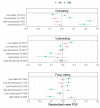The genomics of childhood eating behaviours
- PMID: 33432183
- PMCID: PMC7610819
- DOI: 10.1038/s41562-020-01019-y
The genomics of childhood eating behaviours
Erratum in
-
Author Correction: The genomics of childhood eating behaviours.Nat Hum Behav. 2021 May;5(5):663. doi: 10.1038/s41562-021-01072-1. Nat Hum Behav. 2021. PMID: 33594233 No abstract available.
Abstract
Eating behaviours may be expressions of genetic risk for obesity and are potential antecedents of later eating disorders. However, childhood eating behaviours are heterogeneous and transient. Here we show associations between polygenic scores for body mass index (BMI-PGS) and anorexia nervosa (AN-PGS) with eating behaviour trajectories during the first 10 years of life using data from the Avon Longitudinal Study of Parents and Children (ALSPAC), n = 7,825. Results indicated that 1 s.d. increase in the BMI-PGS was associated with a 30-37% increased risk for early- and mid-childhood overeating. In contrast, 1 s.d. increase in BMI-PGS was associated with a 20% decrease in risk of persistent high levels of undereating and a 15% decrease in risk of persistent fussy eating. There was no evidence for a significant association between AN-PGS and eating behaviour trajectories. Our results support the notion that child eating behaviours share common genetic variants associated with BMI.
Conflict of interest statement
C.M.B. is a Scientific Advisory Board Member for and grant recipient from Shire Pharmaceuticals Ltd. (Takeda Pharmaceuticals Ltd); a consultant for Idorsia Pharmaceuticals Ltd; and author and royalty recipient from Pearson Plc. All others authors declare no competing interests.
Figures


References
Publication types
MeSH terms
Grants and funding
LinkOut - more resources
Full Text Sources
Other Literature Sources
Medical

